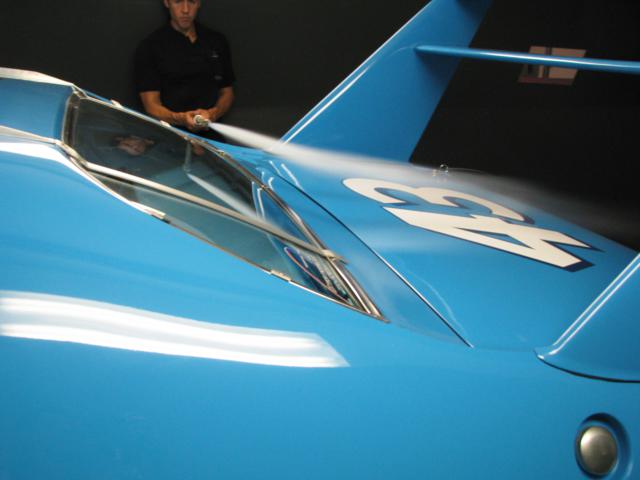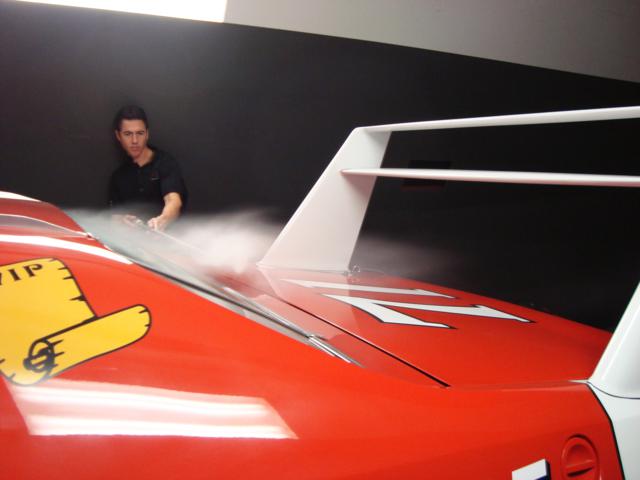Born To Break Wind
Gary and Pam Beineke build a Petty-inspired aero-honed’71 smallblock SuperBird to set yet another 200+ MPH Land Speed Record (ho-hum).
Story and photos by Cliff Gromer
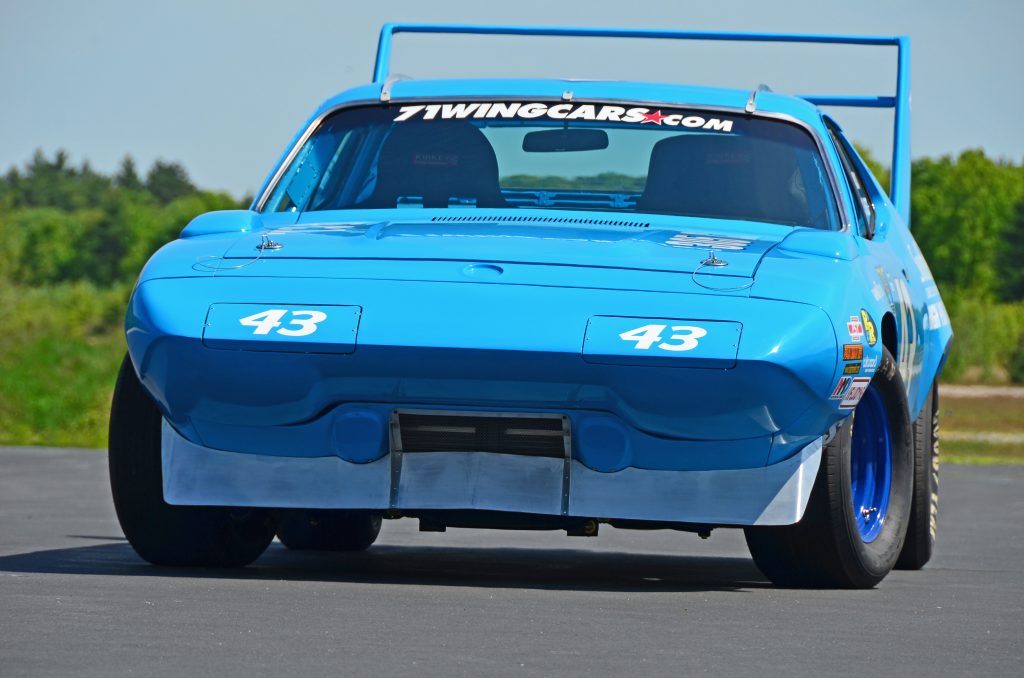
Gary and Pam probably have been building cars since they were 8 years old. They started the G-series 11 years ago, hand-building 1971 Dodge and Plymouth concepts based on what the factory might have done. This Petty-inspired #43 SuperBird recently set a 201.6 MPH Land Speed Record in their class, and joins their #71 K&K Dodge Daytona that also broke 200 MPH and set its own record.
Pam and Gary Beineke (the Bs) have been doing it a long time—11 years, in fact. In that time, they’ve also built eight of their signature G-series (G being the code for 1971) Charger and Road Runner concepts that never made it into production. They base their designs on factory documentation, studio photos and interviews with designers to incorporate what they were pushing for at the time. ‘Course everyone knows that 1971 Daytonas and SuperBirds were never produced by the factory. The factory did, however, test 3/8 scale models in the wind tunnel to find an optimum configuration that would hopefully out-perform the ’69 Daytona and ’70 SuperBird in speed and reduced drag for NASCAR.
Chrysler’s aerodynamicist, Gary Romberg, said the only way to make the ’71 aero cars faster than the ’69-’70 versions was to have some kind of fastback or semi-fastback type back glass as they did with Daytona and Super Bird. Chrysler told Romberg “we’re not doing any specialty rear window plugs for the ‘71s—work with what you have.” At some point shortly thereafter the designers exhausted every other workable option including testing rear window louvers that were coming out for the new ’71 Plymouth and Dodge body styles. But Romberg was right—without the rear glass treatment, the ‘71s would not be faster.
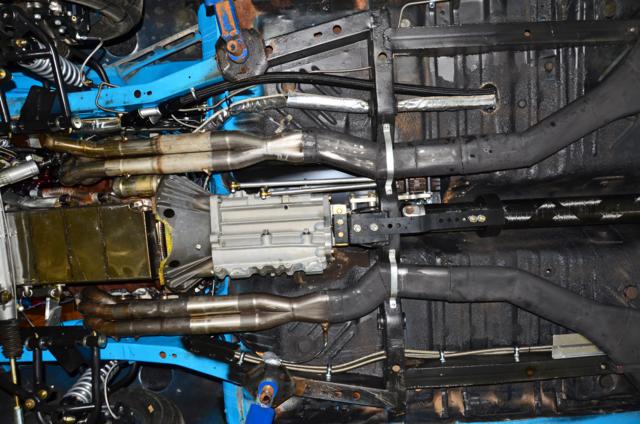
The low profile drysump stainless steel oil pan is straddled on both sides by Profab’s low profile stainless steel slip fit headers. These headers sit no lower than the bottom of the pan. Exhaust exits the sides via Dr. Gas’ boom tubes that G&P were given in 2002 at Petty’s Garage. Actually, these were being used at the time the R5s were being used by Richard Petty Enterprises. Behind the R5 engine is the Tilton bell with triple-disc clutch and hydraulic throwout bearing mated to Jerico’s 5-speed trans with a 1:1 5th. PST’s carbon fiber driveshaft with billet yoke was necessary due to the 9000 + RPM. US Cartool’s frame connectors were used on this project and served as the test fit car. The Bs also used US Cartool’s trans crossmember mounted driveshaft loop.
The ‘71’s aero disadvantage combined with NASCAR restricting the wing cars, if they ran in ’71, to 305 cubic inch engines prompted Chrysler to can the entire aero program So they just planted Hemis in the stock ’71 bodies.
In 2010 Pam and Gary built the ’71 K&K Dodge as a ’71 version aero car, also featured on this website (Bonneville Bash), and that article serves as a good backgrounder for what we show here. So having been down this road before, and with the success of the K&K’s land speed record runs and the 200 MPH anniversary runs at Bonneville, G&P focused on building a stablemate to their Dodge. As the B’s usually build cars in pairs (Dodge/Plymouth) just like shoes (left/right), a Petty SuperBird seemed a logical choice. Gary gathered up all the photos he could find of Petty’s ‘Bird. He also referenced Petty’s #40 SuperBird that had been driven by Pete Hamilton, as well as Petty’s ’71-’72 Road Runner, both of which were in Todd Werner’s collection.
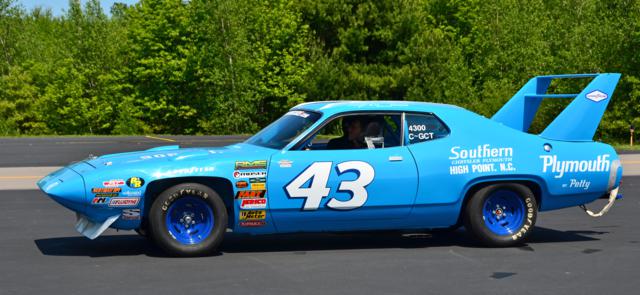
The #43 is sitting with 0 deg. rake. Lessons from Gary and Pam’s previous tunnel experiences dictated lowering the nose to 3 deg. The paint and decal set was matched dead on with detailed photos of Todd Werner’s #71 Petty Road Runner. Current fender decals are G&P’s—the sponsors wouldn’t have it any other way.
The Beinekes’ ’71 SuperBird creation stays close to the factory design but with the nose and wing based on a report and its conclusions by Gary Romberg on the ‘71s back in the day, Starting point for the ’71 ‘Bird was a ’71 318 Satellite Sebring Plus. It was a flood-damaged car from Texas that, amazingly, showed no rust once they pumped the water out. But, instead of dumping another fire-breathing Hemi under the hood like the K&K, they thought they’d increase the challenge and essentially following the NASCAR rules for all aero cars for 1971—305-cube smallblock. Gary contacted KB Racing Engines. They had worked with Bob Tarozzi on the “Lunch Box” smallblock used by one of the Dodge teams back in the day. No luck, KB was fresh out.
“Hmmmn,” hummed Gary, with Pam picking up on the harmony. “where can we find a smallblock, not necessarily a 305 cube, but a Mopar smallblock in appearance, that produces 875 HP @ 8700 RPM and 562 TQ @ 6200 RPM (the power needed to hit 200 MPH in the standing mile), and it has to come supplied with a dry sump oil system, roller cam, intake, distributor, wires, and plugs, bellhousing with hydraulic throw-out bearing, triple Tilton clutch, flywheel, Tilton starter, water pump, pulleys, belts, alternator and brackets AND it has to be completely rebuilt-all for under $13,500?” Simple—just do an Internet search or go to eBay.
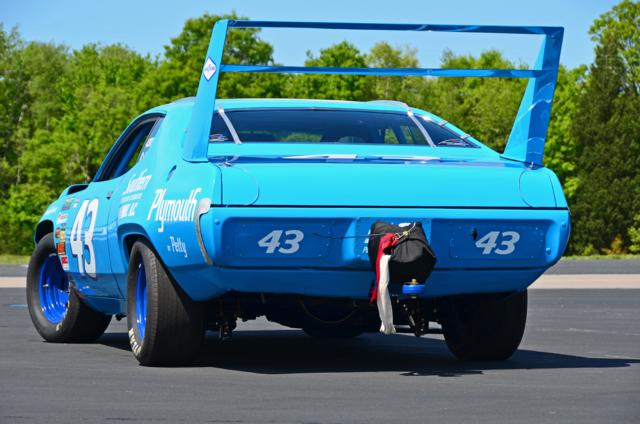
Bi-wing was considered to be the optimum configuration for the ‘71 aero cars. Both blades sit above the dirty air. G&P modified the backlight on this car based on Romberg’s suggestion from back in the day, raising the leading edge of the deck filler panel by one inch, and raising the trailing edge of the rear glass by the same. The parachute (Stroud) is required by land speed rules for all cars that run over 175 MPH. The unique hitch mounted chute assembly allows for quick removal for road course, circle track, NASCAR parade laps, or when you feel the need to hook up the camper and go away for the weekend.
Nanoseconds later, they had their answer: Ernie Elliott, yup that Ernie Elliott who built the engines for Bill Elliott that set the fastest qualifying lap speed in NASCAR history at 212.089 MPH, takes current Cup, Nationwide, and Truck series engines (R6) and previous versions (R5) as well as the Chevy, Ford, and Toyota versions, rebuilds them and sells them to the public. Having vigorously tested certain products in the previous builds, G&P backed this engine up with a Jerico 5-speed (5th being 1:1), PST Carbon fiber driveshaft (good for all 9000+ RPM), RMS suspension front and rear, Fluidyne cooling systems radiator and oil cooler, Autometer Elite gauges, Kirkey racing seats, Moser Engineering 8 ¾” complete rear American Powertrain for peripheral transmission items, the biggest Wilwood 4 wheel discs you can pack in a 15” rim, Bart(Clement) Race Wheels, FAST EFI system and Rich Nedbal’s Fastmanefi.com expertise in creating a fuel and spark map.
As a side note, trying to create a fuel and spark map for an R5 that the Bs converted to EFI was interesting. One of their friends knows a certain driver for Penske (Dodge team), and since they were converting to EFI that season, they inquired about one of their base tunes that would protect the engine, but not give away any secrets. That was a big fat NO. Not even the brother of the driver could get it for his own car. That left Rich using the dyno sheet provided by Ernie Ellott Inc. to create the base maps. With only minor tweaks on the chassis dyno, the engine created the predicted power based on the raw numbers from the engine dyno. Yeah, he’s that good.
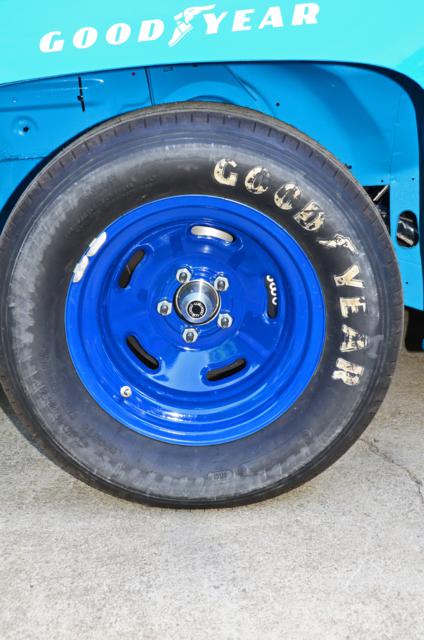
These Goodyears are new versions of the original Blue Streak Stock Car Specials still available in the original bias ply. Bart Racing/American Wheel, a/k/a Clement Wheel, developer and manufacturer of the original kidney bean wheel that debuted at the ‘71 Daytona 500, still produces these wheels in any bolt pattern and offset.
Another side note: the Bs contacted Goodyear Racing and inquired about the old style white letter Stock Car Specials. Fortunately they still have a few sizes being made for the SCCA vintage races. The Bs also heard that the original Clement Wheel manufacturer was still in business as Bart Race Wheels/American Wheel. They contacted Rich Clement and he explained that the ‘kidney bean’ wheels were created by his dad and they still had the original die set. These wheels were debuted at the 1971 Daytona 500 race which would have been the first race their G-Series Super Bird would have debuted too had it been put into production.
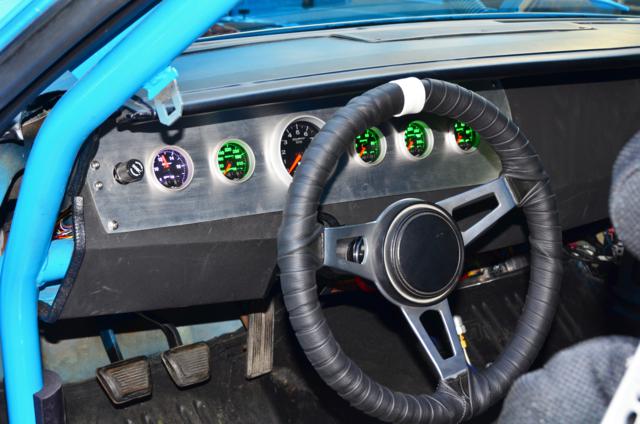
The Bs dash is a melding of the original ‘71 and earlier B-body version for the vintage race look. With RMS power rack & pinion steering they chose the smaller Tuff wheel, wrapped in a stitched vinyl strip to give it a vintage taped look without the sticky mess. Autometer Elite NASCAR-style gauges keep tabs on the vitals. Each gauge is programmable to give both hi/low warnings with either color changes, flashing light, or both. Gauges are also wired to be used with any onboard datalogger.
With the build completed and the car raised to a 3 degrees of nose-down rake, it was off to Loring AFB in Limestone ME the past July for a shot at a 200 MPH record run. Gary ran the car up to 125…all felt good. Up to 150…still felt good. Up to 175…still felt good, but with a bit of light steering, but not nearly as bad as the K&K’s first runs. Then full throttle, crossing the 1.5 -mile lights at 181. The second run, Gary ran harder and hit 183. Pam took the third run and topped 185; a fourth run topped 193. She is now really putting Gary in the rearview. Gary took the final run of the event and redeemed himself with a 199.8mph pass. Good enough to beat Pam…for now.
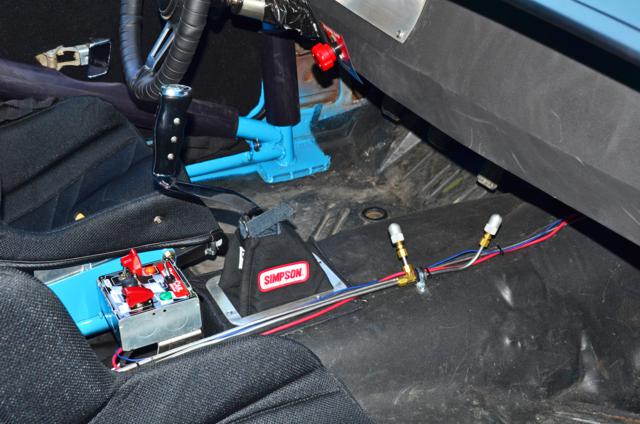
The interior is set up identically to their #71 car so that the driver never has to let go of the wheel. Jerico 5-speed trans is shifted with Gunslinger’s pistol grip handle through a SFI approved Simpson shifter boot. Ignition, fuel, fan, pushbutton start, and datalogger activation switch are all controlled on the Quicktime control panel located between the Kirkey race seats. Flaming River’s emergency battery shutoff is located within driver’s reach at the dash, as well as one located at the tail of the car. Firefox’s dual fire suppression system is required for 200+ MPH runs. The Firefox tanks have a bladder built-in so they’ll work no matter what configuration the car is in.
Next stop was the A2/Aerodyn wind tunnel in Mooresville, NC to further hone the car’s aerodynamics and to see if the ‘Bird would stay grounded at 200+ MPH or fly south for the winter. Gary Romberg, 40 years later, was still doing his aero thing as a consultant for Aerodyn. Romberg had helped the Bs set up their K&K Daytona for 200 MPH runs, and now he would do the same for the #43 Super Bird. Gary had mentioned that “setting up a car with a 2-to-1 downforce ratio–twice the downforce in the rear as in the front, with a 3-degree body rake is the goal. That’s the way the K&K was set up and the same formula should work for the ‘Bird.
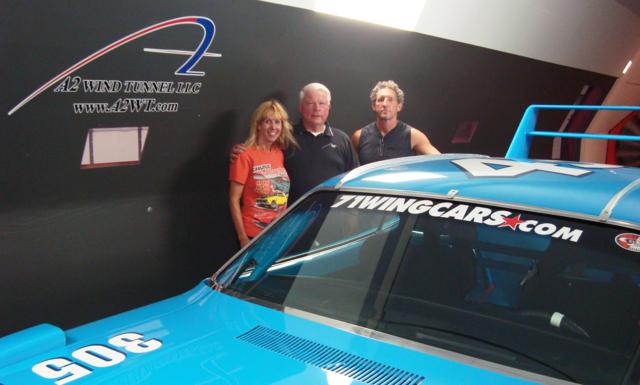
Already having raised the car to 3 degrees of nose down rake at the previous Loring Land Speed Race, testing began with that as their baseline. No surprise, they had too much front lift. Not enough to be dangerous at 200, but there were things to be done to help. Blocking the front grille proved to help, and with the monstrous Fluidyne radiator and oil cooler, blocking it off during their 1.0 and 1.5 mile runs was no problem. Next, the Bs came prepared with a larger front spoiler to prevent even more air from getting under the car. This proved to cause the car to shake violently in the tunnel causing the test to be aborted. Romberg concluded that, while surprising, the larger spoiler was plowing so much air that as it built up in front of the car, it washed over to one side, then the other, then back again to repeat the process causing the car to shake. A few more tests to optimize the drag and lift reduction and they were ready to run the smoke wand over the car.
Dave Salazar, general manager for A2 at Aerodyn, positions the smoke wand to test the Bs semi-fastback design. You can see how the air carries the smoke rearward with little or no reversion on the #43 car. Compared to the factory backlight on their #71 car. You can clearly see how the smoke is being drawn back up the rear glass essentially created a suction/drag.
Romberg and the Bs had reviewed the video of the K&K’s smoke show, noting how the backlight indicated a fair amount of reversion (drag). It would be interesting to see how the semi -fastback the Bs had created for this car compared. The way the Bs created their semi-fastback is interesting. Their SuperBird served as a test-fit car for AMD body panels. They took one of AMD’s replacement Dutch (trunk filler) panels and they stacked it on top of the existing one and elevated the forward part. It butts the sail panels as well as the trailing edge of the glass. They picked that up about an inch, and lifted the glass. They pivoted the Dutch panel up an inch and then they picked the base of the glass up about an inch to meet it. The top of the glass never changes, just changed the angle of the stock glass. They picked up the glass one inch at the trailing edge and picked up the Dutch panel one inch at the leading edge to straighten the angle. It’s that angle that creates the drag.
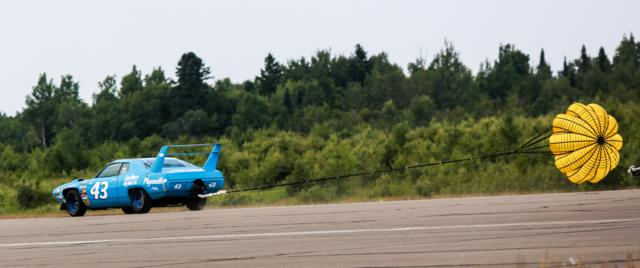
Dave Allen caught this shot of Pam enjoying her smooth decent from her 201.6mph record setting run at the Loring Timing Assoc/LTA Harvest Fest 2012. Stroud Chutes built this Bonneville/Ribbon chute specifically for their wing car. The ribbons soften the blow and the long tether keeps the chute low and straight behind the car with no affect from the wake of the bi-wing.
Romberg had never entered the tunnel for the Bs’ previous tests, but stayed in the control room observing from the multiple camera views on the computer screen. Now, however, he wanted to see firsthand if his suggestion of over 40 years ago proved out. At the end of that test, Romberg turned to Gary, gave him a thumbs up, told him “you did it, it worked perfectly, better than I had hoped”. One of the Bs’ best moments ever (guess they lead a dull life). Bottom line: The Super Bird picked up a 51 HP drag and lift reduction. Money well spent.
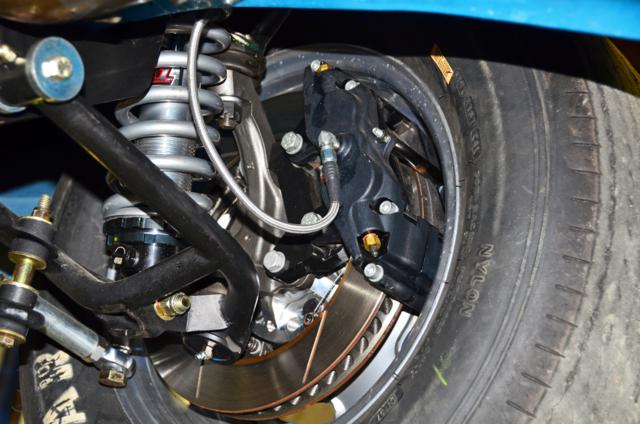
With 15″ rims dictated by the Goodyear tires, Wilwood came up with a large 12.19 X 1.25” rotor, 4-piston caliper combo up front. Out back are 12.19 X.081s and 4-piston calipers. RMS AlterKtion suspension and power rack up front with QA1 adjustable coilover shocks.
Fortunately for the Beinekes, the Loring Timing Assoc. puts on a Harvest Event at the end of the Summer (9/1 & 9/2) so they were able to get another shot. Gary ran the first pass at 198, backed up again by an identical 198. Pam shoved him aside and said “if we’re ever going hit 200 I’ll have to do it.” Her pass was 199. Hey, she’s entitled to a warm up pass–it was still faster than Gary’s. With a crowd at the starting line, the announcer doing the play by play, off she went. Passing the mile at 1mph faster than her last pass and tripping the 1.5-mile lights at 201.6 MPH for a record in the C/FCT class.
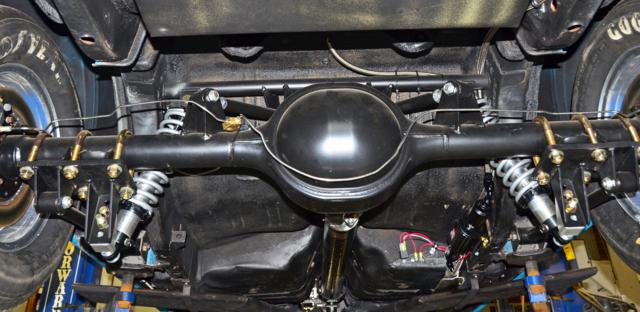
Moser Engineering stamped steel rear end and nodular iron ‘489 chuck with Detroit Trutrac unit transmits the power to the wheels through factory splines so that gear changes are as simple as grabbing any of their spares lying around and popping them in between runs. Big Ford/new style axle flanges were used to allow for tapered bearings, as the ’43 is going to see some local road courses such as Lime Rock and Watkins Glen. RMS suspension out back is a triangulated – bar with QA1 adjustable coil over shocks.
Ok, so we asked once again, “What’s next? A jet powered ‘71 Wingcar?” The Bs laughed and said, ‘We’ve decided to build two funny cars– a ‘71 Daytona and ‘71 SuperBird, of course. Both stock ‘71 bodies are available, but using just one chassis. The only question is how to power it. It’ll either be a supercharged, injected Hemi, or Jet powered or, if they run out of dough—pedals (Pam driving, Gary whipping). Either way, Pam’s edict is 300 MPH or bust.
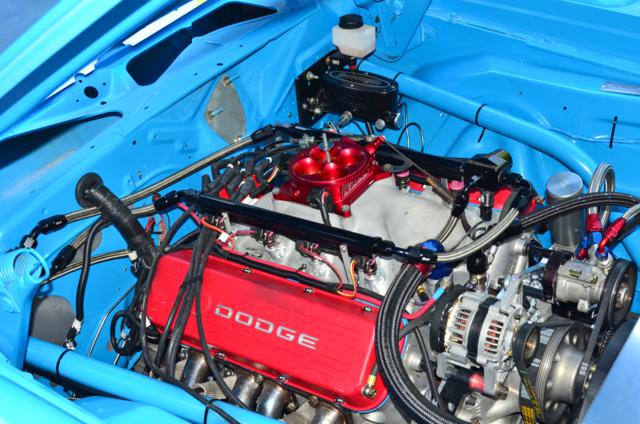
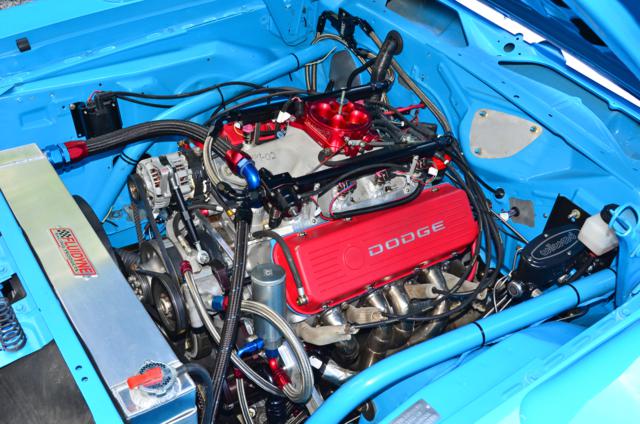
Ernie Elliott Inc.-built R5 Dodge NASCAR engine with roller cam option made 875 HP at 8700 RPM and 562 TQ at 6200. FAST 1375 CFM throttle body sits atop the converted R5 Torker intake. The Bs performed the conversion using FAST/Comp Performance Group products with tuning assist from Rich Nedbal/FastManEFI. Firecore Wires and Hi Perf coil light the mix.


